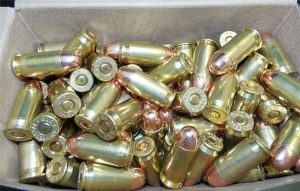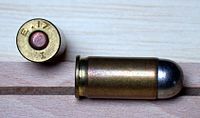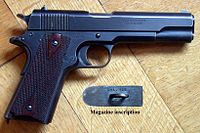 I was recently reading an article about a former Marine that was attacked in his front yard by four armed men, in the driveway of his home, with his family in the house. The entire article can be read in the February 2018 edition of the NRA’s America’s 1st Freedom magazine that, at the time of this writing, is not yet available on line.
I was recently reading an article about a former Marine that was attacked in his front yard by four armed men, in the driveway of his home, with his family in the house. The entire article can be read in the February 2018 edition of the NRA’s America’s 1st Freedom magazine that, at the time of this writing, is not yet available on line.
His pistol at the time, while not being carried but was in close proximity, was a Kimber .45 caliber pistol. In short, he had to shoot the main aggressor; “I pulled the gun out and immediately shot at the guy that had the pistol to my head. He was the one that I knew for a fact had a pistol. I don’t know who else around me had one. I only saw his. He didn’t go down after the first shot; the second shot that I fired made him run.”
While everything turned out alright for the ‘prey,’ articles like this always make me question my choice in ammunition for defensive use. I can only assume that he had JHP ammunition in 230-grain, as it was not stated in the article. If he did have that ammunition, that is what I carry and I would be irresponsible to myself (and possibly the lives of those I needed to protect) if I didn’t pose questions.
The round did stop the threat and I believe that is the ultimate goal. Could have the aggressor continued on being aggressive after being hit twice? The ‘Fight or Flight’ condition took over and he opted for ‘flight.’ I venture to say that a third hit might have stopped all activity, but that is an unanswerable assumption. What is even more amazing (to me) is that the aggressor had run to his Mother’s house (the distance to the house was not mentioned nor the time taken to do so). There was no mention in the article if the aggressor later expired or was treated for his wounds.
At this point, I have to admit that I have somewhat of a fetish;
fet·ish [‘fediSH]
NOUN
An inanimate object worshiped for its supposed magical powers or because it is considered to be inhabited by a spirit. Also: A course of action to which one has an excessive and irrational commitment.
I am referring to, of course, the .45 ACP cartridges and with the 1911-based pistol. Both of which have magical powers and are inhabited by the ghost of John Moses Browning. There is also my propensity to purchase 1911-based pistols and .45 ACP ammunition that, of course, falls to the second part of the definition of a fetish.
One need to be reminded that at the time the 1911 was adopted by the U.S Army, there was another cartridge in play, but originated in Britain; the .455 Webley, which was introduced in 1891 as the 11.55×21.7mmR.

.455 Webley Auto

Colt 1911 .45 Webley Auto
The .455 Webley was a rimmed cartridge intended for Webley revolver (who wudda’ thunk it!) and went through a lot of transformations in its life time. Although rated more powerful that the .45 Colt, the .455 Webley was not selected as the cartridge for the 1911 pistol. And, yes, there was actually a 1911 pistol made to chamber the .455 Webley auto cartridge, a rimless version of the .455 revolver cartridge, and as Wikipedia tells us; “The .455 Webley Auto Mk I cartridge was produced from 1913 to about the middle of World War II. This is a semi-rimmed cartridge for the Webley & Scott Self Loading pistols.
The early version of the cartridge (c.1904) had a shorter 21.7mm semi-rimmed case with a narrow rim and a pointed bullet. A later improved version of the cartridge (c.1910) was similar except it had a 23.54mm long case and a round-nosed bullet. The Mk 1 service round (c.1913) was identical to the 1910 version of the cartridge except it had a thicker rim.
The Mk 1 cartridge’s bullet head-spaced on the rim. It was loaded with a 224 grain copper-nickel-jacketed bullet with a muzzle velocity of 700 feet per second.”
Wikipedia also tells us; “…a few Colt M1911 “British Service Models” chambered in .455 Auto were sold commercially to British Navy and Army officers through outfitters. The service ammunition came packed in 7-round boxes stamped “Not For Revolvers” to prevent confusion.”
Regardless, the .45 ACP cartridge outlasted (and out-performed) the .455 ‘auto’ cartridge. The .45 ACP cartridge, obviously, has a following and the cartridge and the pistols that fire it will be around for a long time.
In another recently read article, the .45 ACP cartridge is touted as the most versatile defensive cartridge to carry. The following is a quote from the article:
- Any modern bullet in .45 ACP will easily pass the FBI test.
- It is a very efficient cartridge that delivers a bullet capable of eye-popping expansion.
- You probably don’t need +P, but some want it, so there it is.
- The .45 Colt smacks the FBI tests with authority, and delivers plenty of expansion.
- As with other big bores, with ACP and Colt 45s, bullet weight isn’t as important.
I doubt that we can dispute the fact that the .45 ACP round has mass, frontal area, and we aren’t giving up velocity. The Federal HST Std P 230 gr. JHP out of a 5″ barrel yields 896 fps. If a little more energy is desired, we can move to the Hornady Std P 185 gr. FTX Critical Defense ammunition with 1041 fps out of the same length barrel, which still comes in with an impressive 926 fps out of the Glock G36’s 3.77-inch barrel.
One complaint that I read about the .45 ACP is that the firearms that fire it are ‘big,’ which I consider a false statement given that many 9mm firearms are as big, if not bigger, than those that fire the .45 ACP cartridge. A ‘Government” model of a 1911 that contains a single-stack magazine of 9mm cartridges is no smaller than a ‘Government” model 1911-based pistol that houses .45 ACP cartridges in a single-stack magazine. Another example if the Springfield XD(m) series of pistols. The 9mm version in the XDm 4.5-inch barreled version is no smaller than the XDm .45 ACP caliber version. The pistol size argument just does not wash.
What matters to most folks, in regard to their caliber selection, is how many cartridges can be carried. I give a little in this argument, because a 9mm 1911-based pistol can hold more cartridges as compared to a .45 ACP 1911-based pistol of the same size, but how many more? A Glock G17 (17+1) can, of course, contain more cartridges in its magazine than can the Glock G21 (13+1) and even the Glock G22 (.40 S&W, 15+1). And, of course, the other thing that seems to matter to most folks is the weight of the firearm that they carry.
I am not going to say that a full-size, all steel 1911-based pistol chambered in .45 ACP is a light pistol. I also won’t say that a CZ75B chambered in 9mm is a light pistol. So, let’s get the calculators out and view two examples that I am familiar with; the Springfield XDm .45 ACP 4.5 (13-round) and the Springfield XDm 9mm 4.5 (19-round).
A 230-grain Speer Gold Dot cartridge weighs in at 0.737 ounces; whereas, the 124-grain Speer Gold Dot cartridge weighs 0.450 ounces. Given that the Springfield XDm .45 ACP 4.5 (13-round) pistol itself weighs 31 ounces (dry weight) and holds 13-rounds of .45 ACP the total weight of the loaded pistol would be approximately 40.581 ounces. The Springfield XDm 9mm 4.5 (19-round) is a 29-ounce pistol when dry. Add 19 rounds of 124-grain Speer Gold Dot and the total pistol weight is close enough to an approximated 37.55 ounces. There is only a hair over 3 ounces of difference in the total weight of the two pistols. Now, will someone please tell me if they can feel a difference of three ounces on their hip given that the pistols are housed within the same holster?
With the above said, let’s look at a full-size (Government), all-steel 1911-based pistol that is part of my rotational EDC group of pistols. The Rock Island (Armscor) 1911 FS Tactical weighs in at 38.4 ounces empty. Add 8 rounds of 230-grain Speer Gold Dot ammunition and the weight increases to 45.92 ounces (2.87 pounds), which is 5.339 ounces more than the Springfield XDm .45 ACP 4.5 (13-round) pistol, but provides a slimmer profile; albeit, a less round count. However, because of the bulk of the Springfield XDm .45 ACP 4.5 (13-round) pistol, the Rock Island (Armscor) 1911 FS Tactical is a more comfortable pistol to carry. Note that, for me, good trouser suspenders are essential to help support the weight of the pistol regardless of what pistol I carry.
Human Factor Engineering (aka, ergonomics) of both aforementioned pistols allow me to be pretty efficient with both pistols regardless of the weight, as weight only factors in as part of recoil management when I am shooting them. More weight equate to less (felt) recoil.
With pistol weight out of the picture, what can we look at next? How about performance? As of this year Federal is coming out with a new line of ammunition that will be introduced at the 2018 SHOT Show, the Hydra-Shok Deep that (according to Federal) provides a defensive round with greater penetration and improved terminal performance. Federal could have actually left the “terminal” part of the definition out; the word ‘terminal’ has such a finality to it and only feeds into the anti-gunners’ slaying of gun ownership. C’mon! Throwing rocks at somebody’s head can result in termination of that person, but sometimes do not.
What Hydra-Shok Deep brings to the table?
- An improved core that allows for 50-percent greater penetration over the original.
- In testing on bare ballistic gelatin, the round penetrates 15 inches.
- The round will be loaded with optimized Federal components.
- This includes a flash-reducing propellant.
The write-up was in regard to 9mm ammunition, but other calibers will follow with the promised attributes.
With that said, the extent of the damage caused by any bullet cannot be determined regardless of how many tests are performed to show what the bullet is capable of doing to gel or a living body. There are just too many factors involved. What we get caught up in is the manufacturer’s hype of what a bullet can do, which can be totally opposite of what the bullet actually did do.
Returning to the first article cited in this article, the .45 ACP rounds fired did do what they were supposed to do – stop the threat. However, was more expected of the cartridge by the shooter? Did the two rounds fired meet the expectations of the shooter, or was more expected of the rounds fired? In his statement, “He didn’t go down after the first shot; the second shot that I fired made him run.” There seems to be no surprise in his statement that the aggressor didn’t go down, it was just a statement as far as statement go. Did he ponder at all after everything was said, done, and gone as to why the aggressor just did not drop or was thrown backward off his feet like that portrayed so many times in movies and in television programs? I am sure that the defender, in this case, chose his weapon platform carefully and probably did the same for the selected ammunition; a Kimber .45 ACP is an excellent choice of firearms. At bad-breath distance, the only thing that you need a pistol (or any firearm) to do is to send the projectile to the target. After that, everything else is not in our control.
If the mere showing a firearm stops a threat, then I can say that any firearm is effective – regardless of caliber, gauge, or ammunition. If the threat remains, even after showing that we are armed, then the line of thought shifts to the performance of the firearm and the cartridges contained within and is in parallel only with our proficiency with the selected firearm.
While my fetish does lie with the .45 ACP cartridge, and the 1911-based pistol, I do understand and realize that there are calibers, bullet designs, and pistols that also make up effective packages for self-defense, competition, training, and informal target shooting. I have fired .22 LR and .22 WMR, 11.43mmx23mm (.45 ACP [circa. 1905] and .45 Colt (11.43×33mmR, circa 1872]), 9mm, 9mm kurz, 10mm, the other 9mm cartridges (38 special/.357 magnum), 11mm (.44 special/.44 magnum), and even the 10mm kurz out of a variety of handguns with some calibers also being shot from PCCs and PCRs. There was also the .45 Winchester Magnum and .454 Casull with the .45 Winchester Magnum being in my ‘comfort’ zone while the .454 Casull really pushed my limits. And, did you realize that there is actually a .45 Super cartridge that can push a 230-grain projectile out of a 5” barrel at 1100 fps? Obviously, it can only be fired from pistols suitable for the cartridge. With all this said, the 9mm Parabellum cartridge is a very popular cartridge and the standard cartridge for NATO forces, and was adopted by the U.S. military in 1985 along with the military version of the Beretta 92 (the M9) pistol.
The 9mm cartridge was introduce in 1901 by George Luger, which makes the cartridge older than the .45 ACP, but not as old as the .38 Special (9×29.5mmR or 9.1×29mmR) that was introduced in 1898. The .38 Special is only one of many .38 caliber cartridges; to include the .38 Short that, incidentally, was the parent cartridge case for the .38 Special. So, to those that say that the .45 ACP is an outdated cartridge, I say that you need to brush up on your history.
While I normally can be found carrying a pistol that chambers the .45 ACP, a new Springfield XDm 9mm 4.5 is now being evaluated for EDC as will the Springfield XDm 9mm Compact (13+1) in the future. I may have a .45 ACP/1911 pistol fetish, but I am also not a fool. But, then again, perhaps I am. Call me an old fool, but don’t call me late for dinner.
Did the cited article make me question my preferred caliber carry. Honestly, it did. Once I removed my ‘terminal’ frame of thinking; however, I realized that the .45 ACP cartridge, in this case, did stop a threat and that’s all that I really want out any cartridge; terminating the producer of the threat is not desirable, but that is out of my hands once the shot (or shots) is taken. I don’t think that it can be said better than out of the mouth of the defender in the case cited, “I am my family’s first and only line of defense. If they get past me, then they have my world and they have everything that makes me, me.”

.45 ACP Cartridge
In closing, I will say that I really do not have a fetish for.45 ACP cartridges or for 1911-based pistols. I really do not believe that there is anything magical about either or that the ghost of John Moses Browning resides within them. They are simply preferred tools of choice for defending my family, others, or I should we be threatened by an armed assailant (or assailants). And, in regard to the 1911-based pistol, it is more about the cartridge than the pistol, but it sure helps to have an excellent platform in the hand to fire.45 ACP cartridges.
To put a final cap on all of this, I will say that a ‘Government’ model, big and heavy, 1911 pistol in .45 ACP will reside in my holster for a very long time. As long as I can pick it up, sight it on target, and shoot it as proficiently as I am capable of, and who can argue with that but a few. The ‘victim/ in the cited encounter survived; I can only hope that I can as well given the same circumstances.
RESOURCES AND REFERENCES:
How Much Does Your Ammo Weight: http://www.thefirearmblog.com/blog/2016/04/09/how-much-does-your-ammunition-weigh/
![]()


One Response to My ‘Emotional Support’ 1911! The .45 ACP and Those Other Calibers!